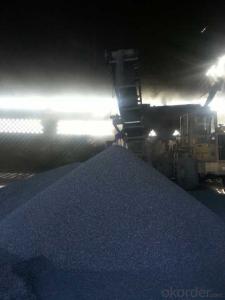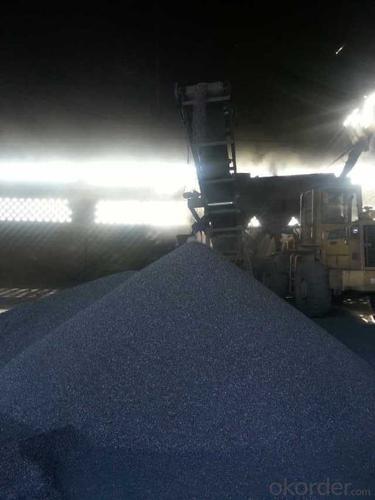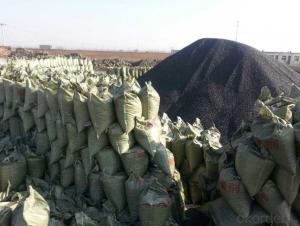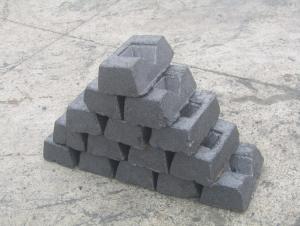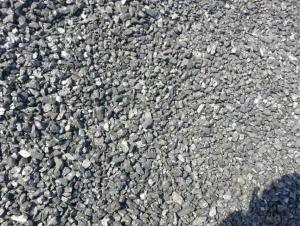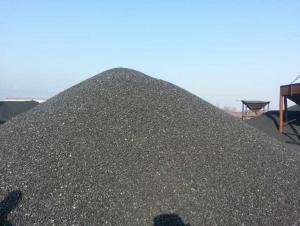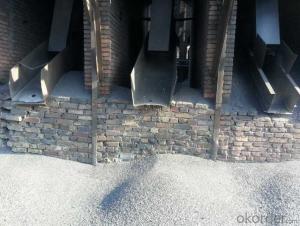FC90-95 Injection Carbon with good and stable quality
- Loading Port:
- Tianjin
- Payment Terms:
- TT OR LC
- Min Order Qty:
- 20 m.t.
- Supply Capability:
- 3000 m.t./month
OKorder Service Pledge
OKorder Financial Service
You Might Also Like
Packaging & Delivery
25kgs/50kgs/1ton per bag or as buyer's request
Specifications
Calcined Anthracite
Fixed carbon: 90%-95%
S: 0.5% max
Size: 0-3. 3-5.3-15 or as request
It used the high quality anthracite as raw materials through high temperature calcined at over 2000 by the DC electric calciner with results in eliminating the moisture and volatile matter from anthracite efficiently, improving the density and the electric conductivity and strengthening the mechanical strength and anti-oxidation. It has good characteristics with low ash, low resistvity, low sulphur, high carbon and high density. It is the best material for high quality carbon products.
Advantage and competitive of caclined anthracite:
1. strong supply capability
2. fast transportation
3. lower and reasonable price for your reference
4.low sulphur, low ash
5.fixed carbon:95% -90%
6..sulphur:lower than 0.3%
General Specification of Calcined Anthracite:
| FC % | 95 | 94 | 93 | 92 | 90 |
| ASH % | 4 | 5 | 6 | 6.5 | 8.5 |
| V.M. % | 1 | 1 | 1 | 1.5 | 1.5 |
| S % | 0.3 | 0.3 | 0.3 | 0.35 | 0.35 |
| MOISTURE % | 0.5 | 0.5 | 0.5 | 0.5 | 0.5 |
Pictures

- Q: What are the effects of carbon emissions on the stability of mangrove forests?
- Carbon emissions have significant effects on the stability of mangrove forests. Mangrove forests are highly vulnerable to changes in climate, and increased carbon emissions contribute to global warming and climate change, which directly impact these ecosystems. One of the main effects of carbon emissions on mangrove forests is rising sea levels. As carbon dioxide is released into the atmosphere, it traps heat and contributes to the warming of the planet. This leads to the melting of polar ice caps and glaciers, causing sea levels to rise. The increased sea levels pose a threat to mangroves as they are adapted to grow in intertidal zones, where they are exposed to both saltwater and freshwater. With rising sea levels, mangroves may experience increased inundation, which can lead to their submergence and eventual death. Furthermore, carbon emissions also contribute to ocean acidification. As carbon dioxide dissolves in seawater, it forms carbonic acid, which alters the pH balance of the ocean. Mangroves rely on the ocean for their nutrient supply and reproductive processes. Ocean acidification can impede the availability of essential nutrients, such as nitrogen and phosphorus, which are vital for the growth and survival of mangroves. Additionally, the acidification of seawater can negatively affect the reproduction and development of mangrove species, leading to a decline in their population. Carbon emissions also contribute to changes in weather patterns, such as increased frequency and intensity of storms and hurricanes. Mangroves act as a natural barrier, protecting coastal areas from the destructive impacts of these extreme weather events. However, with intensified storms and hurricanes, the stability of mangrove forests is compromised. Strong winds, heavy rainfall, and storm surges can uproot or damage mangrove trees, disrupting their structure and reducing their ability to provide coastal protection. Lastly, carbon emissions contribute to the overall warming of the planet, which can lead to changes in precipitation patterns. Mangroves rely on a delicate balance of freshwater and saltwater for their survival. Alterations in precipitation patterns, such as prolonged droughts or increased rainfall, can disrupt this balance and negatively impact mangroves. Droughts can lead to water scarcity, causing mangroves to become stressed and more susceptible to diseases and pests. On the other hand, increased rainfall can lead to excessive amounts of freshwater, diluting the salinity of mangrove habitats and affecting their growth and reproduction. In conclusion, carbon emissions have detrimental effects on the stability of mangrove forests. Rising sea levels, ocean acidification, changes in weather patterns, and alterations in precipitation patterns all contribute to the degradation and loss of mangrove ecosystems. It is crucial to reduce carbon emissions and mitigate the effects of climate change to ensure the long-term survival and stability of mangrove forests.
- Q: Where do I buy DNF premium advanced carbon?
- Seems to be in the mall in the wish gift box, oh, do not remember, I do not know, is not it?! Look, I haven't played that game for a long time. I hope I can help you
- Q: How does carbon impact the prevalence of droughts?
- Carbon, specifically in the form of carbon dioxide (CO2) emissions, plays a significant role in the prevalence of droughts. The increase in carbon levels in the atmosphere contributes to global warming, which in turn affects the overall climate patterns worldwide. When carbon dioxide is released into the atmosphere through human activities such as burning fossil fuels and deforestation, it acts as a greenhouse gas. Greenhouse gases trap heat from the sun and prevent it from escaping back into space, causing the Earth's temperature to rise. As the global temperature increases, it leads to changes in precipitation patterns and evaporation rates. Warmer temperatures accelerate evaporation, causing more water to evaporate from lakes, rivers, and soil. This increased evaporation coupled with altered precipitation patterns results in drier conditions and reduced water availability in certain regions. Additionally, the rising temperatures contribute to the intensification of the water cycle, causing more extreme weather events. This includes more frequent and severe droughts, as well as intense rainfall in some areas, leading to increased risks of floods. Furthermore, carbon emissions also contribute to changes in atmospheric circulation patterns, such as the weakening of the jet stream. The jet stream is responsible for steering weather systems, including rain-bearing weather fronts, across the globe. When it weakens, weather systems tend to become stagnant, resulting in prolonged periods of drought in certain regions. Overall, the increased levels of carbon in the atmosphere due to human activities have a direct impact on global warming and climate change. These changes in climate patterns and atmospheric circulation, combined with the intensification of the water cycle, significantly influence the prevalence and severity of droughts worldwide. Therefore, reducing carbon emissions and mitigating climate change is crucial in addressing and minimizing the impacts of droughts on ecosystems, agriculture, and human populations.
- Q: What are the consequences of increased carbon emissions on cultural heritage sites?
- The impact of increased carbon emissions on cultural heritage sites can be significant. One immediate and visible effect is the degradation of physical structures and artifacts. Carbon emissions contribute to air pollution, leading to the formation of acid rain. This acid rain contains high levels of sulfuric and nitric acids, which corrode and erode materials like stone, metal, and paint. Consequently, historic buildings, monuments, and sculptures can deteriorate and lose their original color. Moreover, carbon emissions also contribute to climate change, resulting in more frequent and severe weather events such as hurricanes, floods, and wildfires. These extreme weather events directly threaten cultural heritage sites, causing physical damage and even destruction. For instance, rising sea levels due to climate change erode coastal archaeological sites, leading to the loss of valuable historical artifacts and structures. Additionally, increased carbon emissions pose a threat to the intangible aspects of cultural heritage. Climate change disrupts ecosystems and biodiversity, impacting the natural surroundings of cultural sites. As a result, traditional knowledge, practices, and cultural landscapes linked to these sites can be lost. Changing environmental conditions may force indigenous communities to lose their ancestral lands and sacred sites. Furthermore, cultural heritage sites heavily rely on tourism for income and conservation funding. However, increased carbon emissions contribute to global warming, which alters travel patterns and preferences. Consequently, there may be a decline in tourist visits to these sites, impacting local economies and hindering conservation efforts. In conclusion, the consequences of increased carbon emissions on cultural heritage sites are diverse and far-reaching. It is essential to address and mitigate these emissions through sustainable practices and policies to safeguard and preserve our shared cultural heritage for future generations.
- Q: How is activated carbon produced?
- Activated carbon is created by a process known as activation, which involves heating carbon-rich materials (such as wood, coal, or coconut shells) at high temperatures without oxygen. Activation can be done in two main ways: physically or chemically. In physical activation, the carbon-rich material is first carbonized by heating it to a high temperature. This creates a char with a high carbon content. Then, an oxidizing gas (like steam or carbon dioxide) is used to treat the char at temperatures ranging from 600 to 900 degrees Celsius. This causes the char to expand and develop a porous structure. The resulting material is washed and dried to eliminate any impurities, resulting in activated carbon. On the other hand, chemical activation involves saturating the carbon-rich material with a chemical activating agent (such as phosphoric acid, zinc chloride, or potassium hydroxide). The impregnated material is then heated to temperatures between 400 and 800 degrees Celsius. This process chemically reacts with the carbon, forming a porous structure. The activated carbon is washed and dried to remove any remaining chemicals. Both physical and chemical activation methods yield activated carbon with a large surface area and a network of pores. These pores enhance the adsorption capacity of the activated carbon, enabling it to effectively capture and eliminate impurities, contaminants, and pollutants from gases and liquids.
- Q: What is carbon neutral energy?
- Carbon neutral energy refers to energy sources that do not release carbon dioxide (CO2) into the atmosphere when they are used. It is a concept that aims to minimize the negative impact of energy production on the environment and climate change. Carbon neutral energy can be achieved through various means, such as renewable energy sources like solar, wind, hydro, and geothermal power, which do not produce CO2 emissions during operation. Additionally, carbon neutral energy can also be obtained by using fossil fuels in combination with carbon capture and storage (CCS) technologies, where the CO2 emitted during combustion is captured and stored underground, preventing it from entering the atmosphere. The goal of carbon neutral energy is to reduce greenhouse gas emissions and mitigate the effects of climate change, making it a crucial step towards a sustainable and cleaner future.
- Q: What are the effects of carbon emissions on the stability of urban infrastructure?
- Carbon emissions have a significant impact on the stability of urban infrastructure. The release of carbon dioxide and other greenhouse gases into the atmosphere from various sources, such as industrial activities, transportation, and energy production, contribute to climate change. This, in turn, poses several challenges to urban infrastructure. One of the primary effects of carbon emissions on urban infrastructure stability is the increased frequency and severity of extreme weather events. Climate change leads to more intense heatwaves, storms, hurricanes, and flooding, which can cause significant damage to buildings, roads, bridges, and other infrastructure components. Higher temperatures can also lead to the expansion and contraction of materials, resulting in structural issues and decreased durability. Moreover, carbon emissions contribute to rising sea levels due to the melting of polar ice caps. This puts coastal cities at risk of flooding and erosion, threatening critical infrastructure located in these regions. As sea levels continue to rise, the stability of urban infrastructure, including ports, water treatment facilities, and transportation systems, is compromised. Another consequence of carbon emissions on urban infrastructure stability is the impact on energy supply and demand. As climate change progresses, extreme weather events can disrupt power grids and energy infrastructure, leading to blackouts and disruptions in services. Additionally, increased energy demand for cooling systems in response to rising temperatures can overload existing infrastructure, putting strain on the electrical grid. Furthermore, carbon emissions contribute to air pollution, which adversely affects the health and well-being of urban populations. Poor air quality can lead to respiratory and cardiovascular diseases, impacting the workforce and productivity. This can indirectly affect the stability of urban infrastructure as a healthy and productive population is essential for the maintenance and functioning of cities. To mitigate the effects of carbon emissions on the stability of urban infrastructure, various measures can be taken. These include shifting to renewable energy sources, improving energy efficiency in buildings and transportation, implementing sustainable urban planning strategies, and investing in climate-resilient infrastructure. These actions can help reduce carbon emissions and build infrastructure that is better equipped to withstand the challenges posed by climate change, ultimately ensuring the stability and resilience of urban areas.
- Q: What type of carbon copy sheet can be printed on? How many copies?
- Printed in carbon free carbon paper, usuallyUpper: whiteMedium: RedNext: yellowMainly depends on how much you want to print.
- Q: What are the impacts of carbon emissions on the stability of kelp forests?
- Carbon emissions have significant impacts on the stability of kelp forests. Increased carbon dioxide (CO2) levels in the atmosphere lead to ocean acidification, which has detrimental effects on kelp. As CO2 dissolves in seawater, it forms carbonic acid, lowering the pH of the ocean. This acidification inhibits the growth and development of kelp, making them more vulnerable to stressors and reducing their overall stability. Ocean acidification affects the physiology of kelp in several ways. It hampers their ability to take up essential nutrients, such as nitrogen and phosphorus, which are crucial for their growth. This nutrient limitation weakens the kelp, making them more susceptible to diseases, predation, and damage from storms. Additionally, acidified seawater can hinder the development of kelp spores, impairing their ability to reproduce and regenerate kelp forests. Furthermore, carbon emissions contribute to rising sea temperatures, which also have detrimental effects on kelp forests. As the climate warms, kelp may experience thermal stress, leading to reduced growth rates and increased mortality. Warmer waters can also favor the growth of harmful algae species, which can outcompete kelp for space and resources, further destabilizing kelp forests. The stability of kelp forests is crucial as they provide numerous ecosystem services. They act as important carbon sinks, absorbing and storing large amounts of carbon dioxide from the atmosphere. Kelp forests also provide habitat and nursery grounds for a wide variety of marine species, including commercially important fish and invertebrates. They help maintain the health and productivity of coastal ecosystems by reducing coastal erosion, improving water quality, and supporting biodiversity. To mitigate the impacts of carbon emissions on kelp forests, it is essential to reduce our carbon footprint by transitioning to cleaner and more sustainable energy sources. Additionally, protecting and restoring coastal habitats, including kelp forests, can enhance their resilience to climate change and other stressors. Implementing sustainable fishing practices and establishing marine protected areas can also help preserve and maintain the stability of kelp forests and the valuable ecosystem services they provide.
- Q: The relative molecular mass was between 120-150. The testThe organic matter M, which contains only carbon, hydrogen and oxygen, was measured by mass spectrometer. The relative molecular mass was between 120-150. The mass fraction of oxygen element measured by experiment is 48.48%, the ratio of hydrocarbon to mass is 15:2, and only COOH in M molecule is measured by infrared spectrometer. Then the M formula is?
- The mass fraction of oxygen element is 48.48%, the mass fraction of hydrocarbon is =51.52%, and the mass ratio is 15:2. The mass fraction of carbon is =51.52%x15/ (15+2) =45.46%, and the mass fraction of hydrogen is =51.52%x2/ (15+2) =6.06%The atomic number of C, H and O is higher than that of =45.46%/12:6.06%/1:48.48%/16=3.79:6.06:3.03Molecules contain only COOH, and oxygen atoms must be even numbers.Therefore, the number of atoms in C, H and O can be reduced to =5:8:4, which may be C5H8O4, and the relative molecular weight is 132
Send your message to us
FC90-95 Injection Carbon with good and stable quality
- Loading Port:
- Tianjin
- Payment Terms:
- TT OR LC
- Min Order Qty:
- 20 m.t.
- Supply Capability:
- 3000 m.t./month
OKorder Service Pledge
OKorder Financial Service
Similar products
Hot products
Hot Searches
